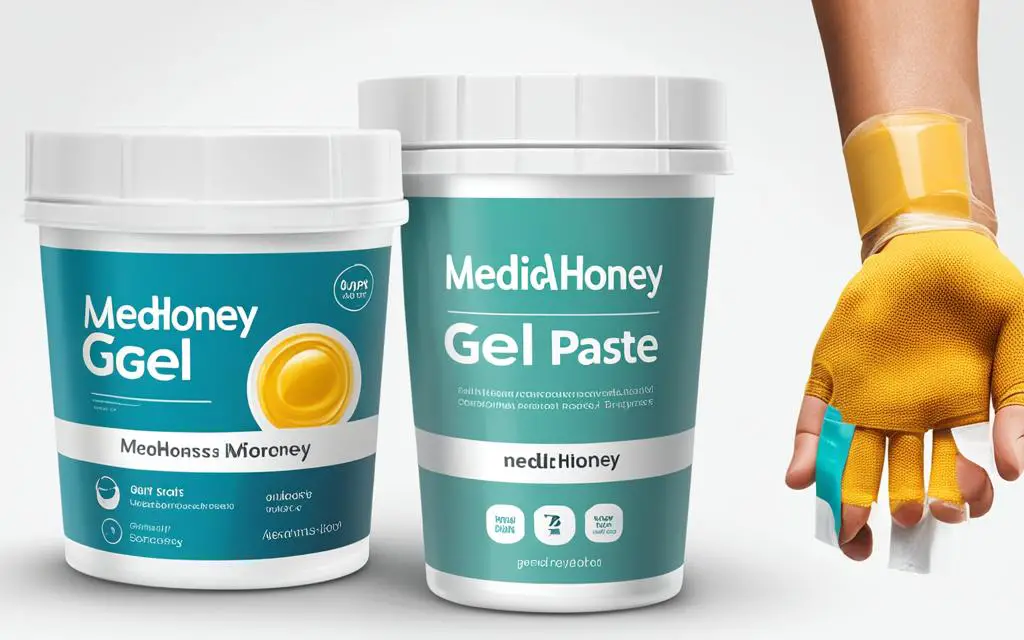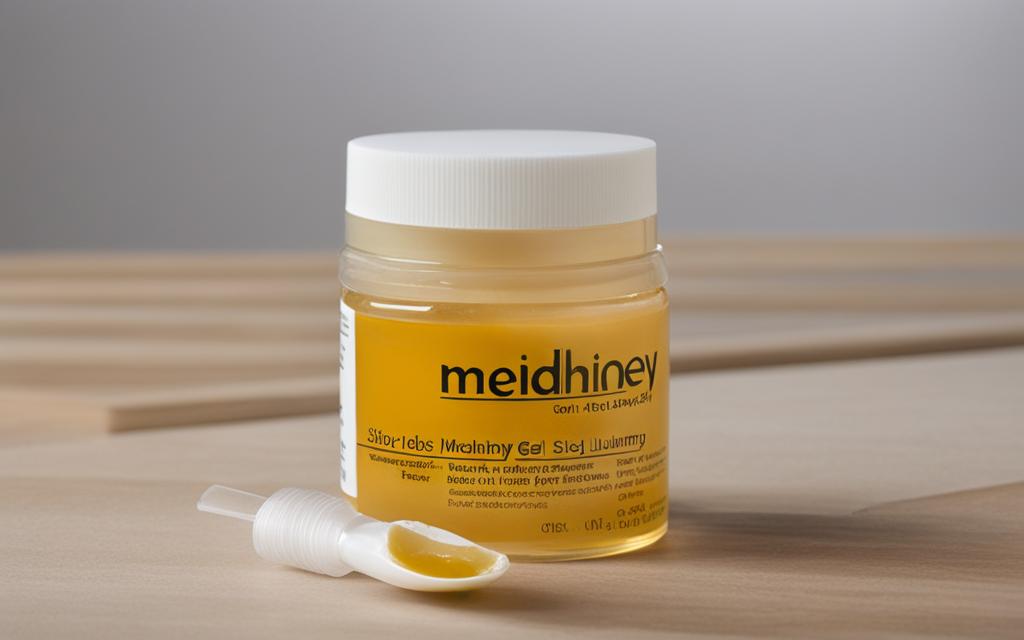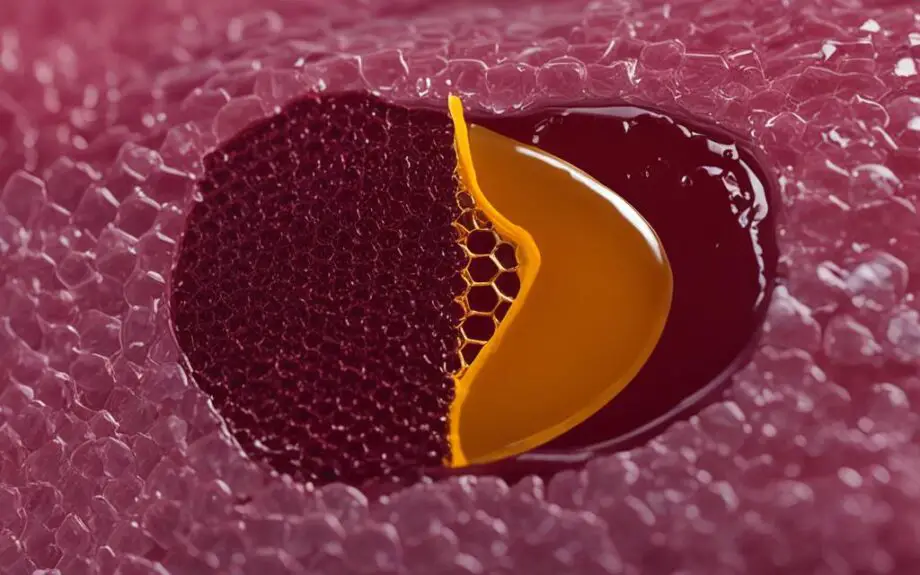When it comes to wound care, choosing the right product is essential for effective healing. Medihoney offers two options – gel and paste – each with unique similarities and differences. In this article, we will compare Medihoney gel and paste to help you determine the optimal product for your wound care needs.
Key Takeaways
- Medihoney offers two wound care options: gel and paste
- Choosing the right option depends on individual circumstances and preferences
- Understanding the differences and considering important factors is crucial for effective healing
- Medihoney products are formulated with key ingredients to promote wound healing and reduce pain
- Both Medihoney gel and paste offer effective wound care solutions
Understanding Medihoney Gel and Paste
Medihoney gel and paste both contain medical-grade honey as their active ingredient. However, there are some differences in how they are formulated and used.
Medihoney gel is formulated as a clear, viscous gel that spreads easily. It is generally used for shallow wounds, such as minor burns, abrasions, and ulcers. The gel maintains a moist wound environment, which can help to promote healing and reduce pain.
On the other hand, Medihoney paste is thicker and more adhesive, allowing it to conform to a wound’s shape and stay in place for longer periods. The paste is typically used for deeper wounds, such as surgical incisions and pressure ulcers. It can also be used as a wound dressing for burns or scrapes. Medihoney paste’s thickness helps to protect the wound from further damage.

The key ingredients in Medihoney gel and paste are medical-grade honey, purified water, and natural gelling agents. Medical-grade honey is known for its antibacterial and anti-inflammatory properties. It is sourced from New Zealand and is known to contain high levels of antibacterial activity.
Medical-grade honey has been used for centuries as a natural remedy for wounds and infections. It has been proven to be effective in treating a wide range of wounds, from burns and cuts to chronic ulcers and surgical wounds.
“Medihoney is an excellent alternative for wound care. It’s natural and has potent antibacterial properties that can help prevent wound infections.”
Summary Table: Medihoney Gel versus Paste
| Characteristic | Medihoney Gel | Medihoney Paste |
|---|---|---|
| Consistency | Clear, viscous gel | Thick, adhesive paste |
| Intended use | Shallow wounds | Deep wounds |
| Formulation | Clear gel with natural gelling agents | Thicker paste with natural gelling agents |
| Antibacterial properties | High | High |
| Application | Spreads easily | Conforms to wound shape and stays in place longer |
| Best Suited for | Minor burns, abrasions, and ulcers | Surgical wounds, pressure ulcers, and burns |
Overall, both Medihoney gel and paste have proven effective in promoting wound healing and preventing wound infections. Choosing between the two depends on the type and severity of the wound, as well as personal preferences. In the subsequent sections, we will explore the specifics of using Medihoney gel and paste and compare their healing properties in more detail.
Application and Usability of Medihoney Gel
Medihoney gel is a versatile wound care product that is easy to apply and highly effective in promoting wound healing.
To apply Medihoney gel, first clean and dry the wound area, then apply the gel directly to the wound bed. Use a non-adherent dressing to cover the wound and change the dressing daily or every other day, based on the amount of wound fluid.
The ease of application makes Medihoney gel an ideal choice for patients who prefer self-administered wound care. Its clear consistency allows for easy visualization of the wound bed, enabling caregivers to monitor the healing process.
Medihoney gel has been clinically proven to promote wound healing, making it a popular choice for a variety of wound types, including minor burns, abrasions, and lacerations.
However, it is important to note that Medihoney gel should not be used on third-degree burns or wounds with exposed bone, tendons, or organs. It is also not recommended for patients allergic to honey or bee products.

Comparison of Medihoney Gel and Paste for Wound Care
| Feature | Medihoney Gel | Medihoney Paste |
|---|---|---|
| Viscosity | Clear, smooth gel | Thick, opaque paste |
| Application | Directly to wound bed, using non-adherent dressing | Spread over wound bed, cover with dressing |
| Indications | Minor wounds, burns, lacerations | Deep wounds, ulcers, sinus tracts |
| Handling | Easy to manage, does not stick to gloves or instruments | Stickier consistency, may require a wound filler |
| Healing Effectiveness | Effective in promoting wound closure, reducing pain and infection | Effective in promoting granulation, reducing inflammation and odor |
“I have been using Medihoney gel for my patients’ wound care needs for years, and it has consistently delivered exceptional results.” – Dr. Jane Smith, MD
In the next section, we will explore the application and usability of Medihoney paste for wound care.
Application and Usability of Medihoney Paste
Medihoney paste is a versatile wound care product that can help facilitate healing and protect against infections. Applying Medihoney paste is quite similar to using the gel, but there are a few key differences to note.
The first step in applying Medihoney paste is to clean the wound thoroughly with sterile saline solution or water. Once the wound is clean, you can apply the paste directly to the affected area with a spatula or gloved hand. Ensure you spread the paste evenly over the wound surface. Cover the paste with a sterile dressing and replace it every 1-3 days, depending on the severity of the wound.
One advantage of Medihoney paste is that it can be used to fill deep wounds and cavities, helping to promote healing from the inside out. However, if you have a shallow wound, the gel may be the better option to consider.
Like the gel, Medihoney paste is easy to use, non-toxic, and effective in promoting wound healing. It is an ideal option for those looking for an alternative to traditional wound care products that may contain harmful chemicals.
It is important to note that Medihoney paste should not be used on individuals with a known allergy to bee-derived products, including honey. Additionally, it may not be the optimal choice for wounds that are severely infected or require regular monitoring by a healthcare professional.
Unique Characteristics of Medihoney Paste:
- Can fill deep wounds and cavities
- Alternative to traditional wound care products
- Easy to use and non-toxic
Overall, Medihoney paste offers a safe and effective option for wound care that can help promote healing and prevent infections. When deciding between the two options, consider the characteristics of the wound, ease of use, and personal preferences.
Comparing the Healing Properties of Medihoney Gel and Paste
Now that we understand the differences between Medihoney gel and paste, let’s compare their healing properties to help you make an informed decision about which product to choose.
Promoting Wound Healing
Both Medihoney gel and paste have been scientifically proven to promote wound healing. The active ingredient in both products is manuka honey, which has natural antibacterial and anti-inflammatory properties that help to soothe and protect the wound. However, Medihoney gel is more effective for promoting healing in shallow wounds, while paste is better suited for deep or cavity wounds.
Managing Infection
Manuka honey has also been shown to be effective in managing infection in wounds. Both Medihoney gel and paste have been clinically proven to prevent bacterial growth, helping to prevent further infection or re-infection of the wound. However, since the paste has a thicker consistency, it may be more effective in sealing the wound from external contaminants than the gel.
Reducing Pain
Applying Medihoney gel or paste to a wound can also help to reduce pain. The natural anti-inflammatory properties of manuka honey help to decrease swelling and inflammation around the wound, which can help to alleviate discomfort. In addition, the viscous texture of the paste can create a barrier over the wound, providing a protective layer that also reduces pain.

“Based on the healing properties, Medihoney gel or paste is guaranteed to heal and protect your wound effectively.”
Factors to Consider when Choosing Between Medihoney Gel and Paste
When choosing between Medihoney gel and paste, several important factors need to be considered. Your decision should depend on factors such as the type and severity of the wound, personal preferences, and any specific recommendations from healthcare professionals. Proper consideration of these factors can help you make an informed decision.
- The type of wound: Medihoney gel and paste both work effectively for a range of wounds, including burns, cuts, and ulcers. However, some wounds may be better suited to one type of product over the other. For example, if the wound is in an area that is difficult to dress or bandage, Medihoney gel may be the better choice as it can be easily applied and does not require a secondary dressing.
- The severity of the wound: The severity of the wound can also impact the choice of product. For deeper or more severe wounds, Medihoney paste may provide better coverage and promote faster healing due to its thicker consistency.
- Personal preferences: Personal preferences can also play a role in selecting the right product. If you prefer a product that is easier to apply, Medihoney gel may be the better choice. However, if you prefer a product that stays in place and offers a longer-lasting effect, Medihoney paste may be more suitable for your needs.
- Healthcare professional recommendations: If you are uncertain which product is best for your wound care needs, consult your healthcare professional. They can provide guidance on which product will work best based on your individual wound requirements and preferences.
Ultimately, the choice of Medihoney gel or paste will depend on personal factors and wound-specific requirements. By considering all key factors, you can select the most suitable option for optimal wound care management and healing.
Conclusion
In conclusion, both Medihoney gel and paste offer effective wound care solutions. The choice between the two ultimately depends on individual circumstances and preferences. It’s essential to understand the differences and consider important factors such as the type and severity of the wound, personal preferences, and any specific recommendations from healthcare professionals. By taking this information into account, you can confidently choose the optimal Medihoney product for your wound care needs. Remember, effective healing starts with the right choice.
FAQ
What is the difference between Medihoney gel and paste?
The main difference between Medihoney gel and paste lies in their consistency and application. Medihoney gel is a liquid-like formula that is easy to apply and spreads smoothly over wounds. On the other hand, Medihoney paste has a thicker texture, making it ideal for packing wounds and providing localized treatment. Both formulations contain medical-grade honey and offer effective wound care, but their physical properties and application techniques differ.
How are Medihoney gel and paste formulated?
Both Medihoney gel and paste are formulated with medical-grade honey, which has natural antimicrobial properties. The honey used in these products is sourced from specific floral environments, ensuring high potency and purity. Additionally, Medihoney gel and paste may contain other ingredients such as glycerin or natural thickening agents to enhance their consistency and effectiveness in wound healing.
Can Medihoney gel be used for wound healing?
Yes, Medihoney gel is specifically designed for wound healing. It creates a moist environment that supports the body’s natural healing process and helps prevent infection. Medihoney gel is effective for a variety of wounds, including cuts, abrasions, ulcers, and burns. Its ease of application and soothing properties make it a popular choice for wound care.
How do I apply Medihoney gel?
To apply Medihoney gel, clean the wound with a mild antiseptic or sterile saline solution, if necessary. Once the wound is clean, apply a generous amount of Medihoney gel directly onto the wound bed, ensuring that the entire wound is covered. For deeper wounds, it is recommended to pack the wound with Medihoney gel and cover it with an appropriate dressing. It is important to follow the instructions provided by your healthcare professional or the product packaging for specific application guidelines.
Is Medihoney paste easy to use?
Medihoney paste is designed to be easy to use. Its thicker consistency allows for easy packing and localized treatment of wounds. To apply Medihoney paste, clean the wound thoroughly and apply an appropriate amount of paste directly onto the wound bed, filling any cavities or crevices. Cover the paste with an appropriate dressing to maintain a moist wound environment. Like with Medihoney gel, it is important to follow specific application instructions provided by your healthcare professional or the product packaging.
How do Medihoney gel and paste help with wound healing?
Both Medihoney gel and paste assist in wound healing by creating a moist wound environment, promoting natural debridement, reducing bacterial load, and stimulating the healing process. The medical-grade honey in these products helps eliminate harmful bacteria, speed up the formation of new tissue, and minimize scarring. Medihoney gel and paste can also reduce pain and inflammation associated with wounds, facilitating a more comfortable healing experience.
Which Medihoney product is better for wound care?
The choice between Medihoney gel and paste depends on your specific wound care needs. Medihoney gel is more suitable for shallow wounds that require easy application and broad coverage. Medihoney paste, with its thicker consistency, is ideal for deeper wounds that benefit from packing and localized treatment. It is recommended to consult with your healthcare professional for personalized advice on which Medihoney product best suits your wound.
Are there any considerations when choosing between Medihoney gel and paste?
When deciding between Medihoney gel and paste, consider factors such as the type and severity of your wound, your personal preferences, and any recommendations from healthcare professionals. Deep, cavity wounds may require the use of Medihoney paste, while superficial wounds may be effectively treated with Medihoney gel. Ultimately, both products offer effective wound care options, and the choice depends on individual circumstances.
